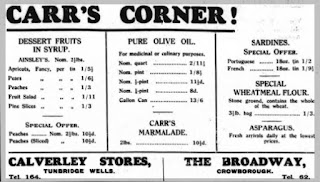And now for the inaugural episode of what hopefully will be a regular feature: Coupon-Cutting Thursday, with newspaper ads related to Santa Clara Valley industry. No guarantees given that the vendors listed will honor these prices.
It's always a bit surprising to me how the Santa Clara valley fruit industry really was international, even as far back as the turn of the century. Vince Nola told me stories about playing on the burlap sacks to ship prunes to Germany. The San Jose Evening News in 1903 remarked on 200,000 pounds of A&C Ham Company's prunes sold in Antwerp in 1903. The U.S. Products cannery, run by the Dutch Vlessing company, exported canned fruit back to Europe.
But the most memorable for me is John Colpitts Ainsley's Ainsley Cannery in Campbell. Ainsley, an immigrant from Britain, worked with family back home to export fruit from the 1890's through the late 1930's. Ainsley was also known for its fruit packed quite attractively in glass jars. Although the most successful of the Campbell canneries, the plant itself is long gone; it's former location, north of the railroad tracks along Harrison Ave., is now townhouses.
I'll admit I was always a bit curious about exporting fruit to England. I'd heard that each European country had its own preferences on fruit - prunes to Germany, apricots to England. But I didn't know much about what fruit they got, or how they used it. Luckily, with all the old newspapers scanned and put on the Internet, we've got a chance to see.
These three ads came from the 'teens and twenties. Ainsley was primarily known for its dessert fruits, at least according to the 1920's ads, advertising peaches, pears and apricots from the Valley to the Brits as they escaped the long winter. Ainsley also apparently did fruit salad and pineapple slices as well. The first sight to my modern eyes is the sheer size of the packaging - 2/12 lb apricots, peaches, and pears in cans, or glass-packed fruit for twice the price.
The earlier ad - from 1912 - highlights how folks were using canned fruit differently than how I grew up. I think of canned fruit as an old-fashioned and handy dessert source, but Ainsley was instead selling "Californian Apricot Pulp" for jam and marmalade making in seven pound tins. They even include the handy instructions for making jam at home - just add sugar and bitter almonds.
I'll also highlight the sheer number of typefaces used in that St. Andrews newspaper advertisement, with at least eight typefaces appearing in the same ad - not just mainstays like a roman font and sans-serif font, but a stencil font *and* an Old Western typeface, all sitting there together. I might guess that a copy of Wired's Style Guide got sent back in time to land on the typesetter's desk, though it's a shame he couldn't also print the ad in several different contrasting colors.
I found these ads in the British Newspaper Archive, which also turned up a reporter's visit to San Jose in 1850:
"The valley of San Jose has quite won us by its extremely fine balmy climate and quietness... to us one of the pleasantest attractions of the place were the fine old orchards and vineyards attached to some of the old residences of the native Californians. Spacious and extensive, they are filled with sturdy and thrifty pear, apple quince, and other fruit trees, literally breaking down from the weight of the luscious burdens they bear...
We were quite surprised at the extent to which cultivation has been carried in the vicinity of San Jose, within two or three miles, quite a number of Americans have brought under cultivation large tracts of land, and with the greatest success. The labour has been mostly performed by Indians, who have been paid five to six dollars a week, we are informed. We heard of one gentleman having one patch of potatoes covering upwards of 60 acres. (October 24, 1850 Fife Herald)."
I never would have expected the Fife Herald to be featuring an article on San Jose agriculture (and a trip to the Almaden mines) just a couple years after the discovery of Gold, but we were certainly interesting enough to fill some column inches on a slow Thursday.







No comments:
Post a Comment
Note: Only a member of this blog may post a comment.